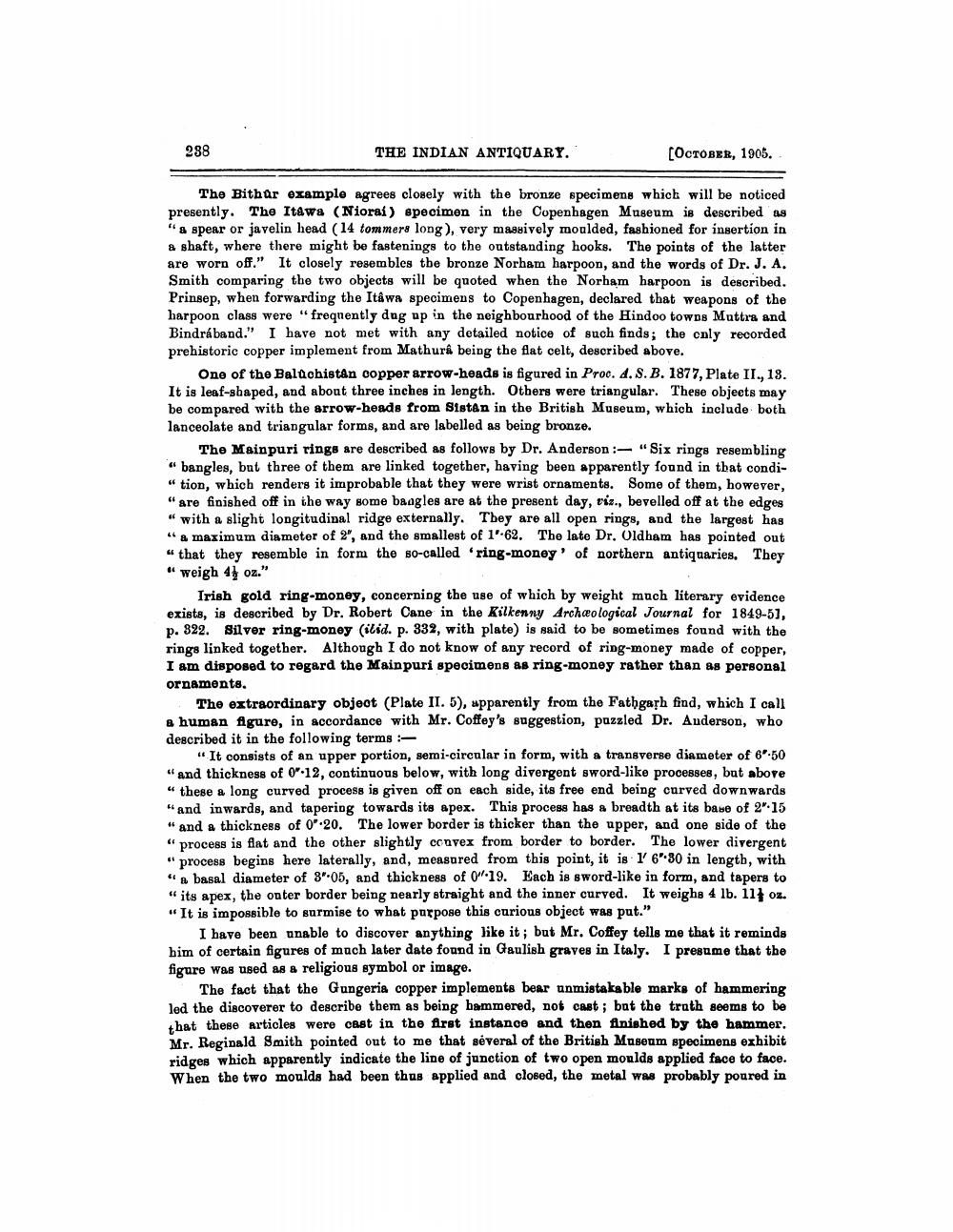________________
288
THE INDIAN ANTIQUARY.
[OCTOBER, 1905.
The Bithor example agrees closely with the bronze specimens which will be noticed presently. The Itawa (Niorai) specimen in the Copenhagen Museum is described as "& spear or javelin head (14 tommers long), very massively moulded, fashioned for insertion in a shaft, where there might be fastenings to the outstanding hooks. The points of the latter are worn off." It closely resembles the bronze Norham harpoon, and the words of Dr. J. A. Smith comparing the two objects will be quoted when the Norham harpoon is described. Prinsep, when forwarding the Itâwa specimens to Copenhagen, declared that weapons of the harpoon class were "freqnently dug up in the neighbourhood of the Hindoo towns Muttra and Bindráband." I have not met with any detailed notice of such finds; the only recorded prehistoric copper implement from Mathura being the flat celt, described above.
One of the Balochistan copper arrow-heads is figured in Proc. 4. S. B. 1877, Plate II., 13. It is leaf-shaped, and about three inches in length. Others were triangular. These objects may be compared with the arrow-heads from Sistan in the British Museum, which include both lanceolate and triangular forms, and are labelled as being bronze.
The Mainpuri rings are described as follows by Dr. Anderson :- "Six rings resembling " bangles, but three of them are linked together, having been apparently found in that condi" tion, which renders it improbable that they were wrist ornaments. Some of them, however, "are finished off in the way some baagles are at the present day, viz., bevelled off at the edges " with a slight longitudinal ridge externally. They are all open rings, and the largest has " & maximum diameter of 2", and the smallest of 15.62. The late Dr. Oldham has pointed out " that they resemble in form the so-called 'ring-money' of northern antiquaries. They "weigh 4 oz."
Irish gold ring-money, concerning the use of which by weight much literary evidence existe, is described by Dr. Robert Cane in the Kilkenny Archeological Journal for 1849-5), p. 822. Silver ring-money (ilid. p. 332, with plate) is said to be sometimes found with the rings linked together. Although I do not know of any record of ring-money made of copper, I am disposed to regard the Mainpuri specimens as ring-money rather than as personal ornaments.
The extraordinary objeot (Plate II. 5), apparently from the Fathgarh find, which I call a human figure, in accordance with Mr. Coffey's suggestion, puzzled Dr. Anderson, who described it in the following terms >
"It consists of an upper portion, semi-circular in form, with a transverse diameter of 6.50 "and thickness of 0.12, continuous below, with long divergent sword-like processes, but above “these a long curved process is given off on each side, its free end being curved downwards "and inwards, and tapering towards its apex. This process has a breadth at its base of 2.15 * and a thickness of 0".20. The lower border is thicker than the upper, and one side of the “ process is flat and the other slightly convex from border to border. The lower divergent " process begins here laterally, and, measured from this point, it is 1 6'80 in length, with " basal diameter of 8".05, and thickness of ("19. Each is sword-like in form, and tapers to " its apex, the onter border being nearly straight and the inner curved. It weighs 4 lb. 11 oz. "It is impossible to surmise to what parpose this curious object was put."
I have been unable to discover anything like it; but Mr. Coffey tells me that it reminds bim of certain figures of much later date found in Gaulish graves in Italy. I presume that the figure was used as a religious symbol or image.
The fact that the Gungeria copper implements bear unmistakable marks of hammering led the discoverer to describe them as being hammered, not cast; but the truth seems to be that these articles were cast in the first instance and then finished by the hammer. Mr. Reginald Smith pointed out to me that several of the British Museum specimens exhibit ridges which apparently indicate the line of junction of two open moulds applied face to face. When the two moulds had been thus applied and closed, the metal was probably poured in




